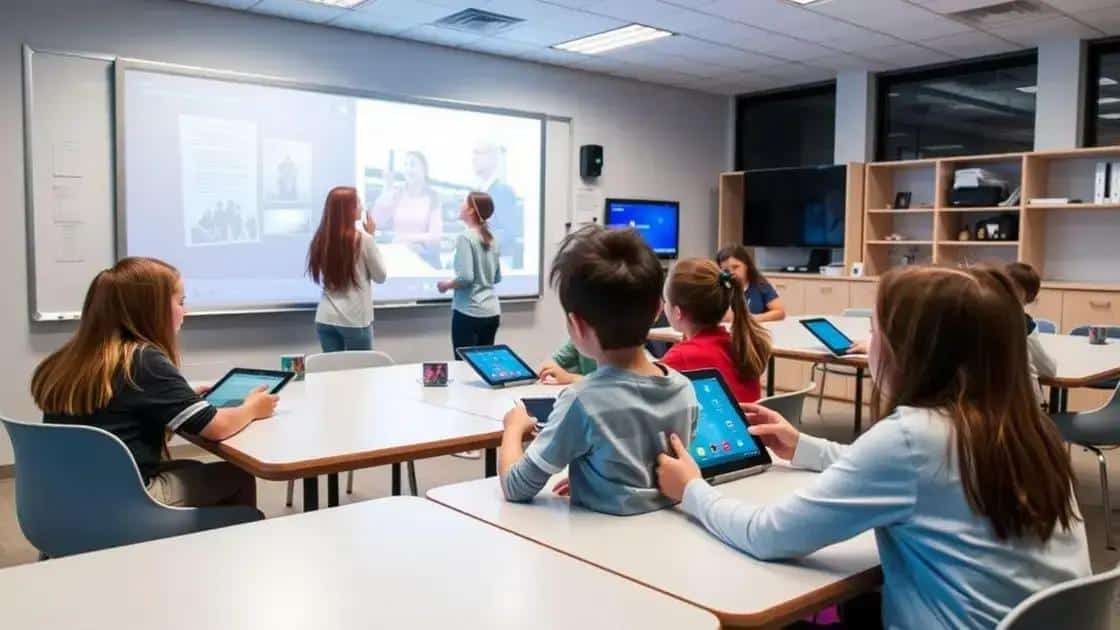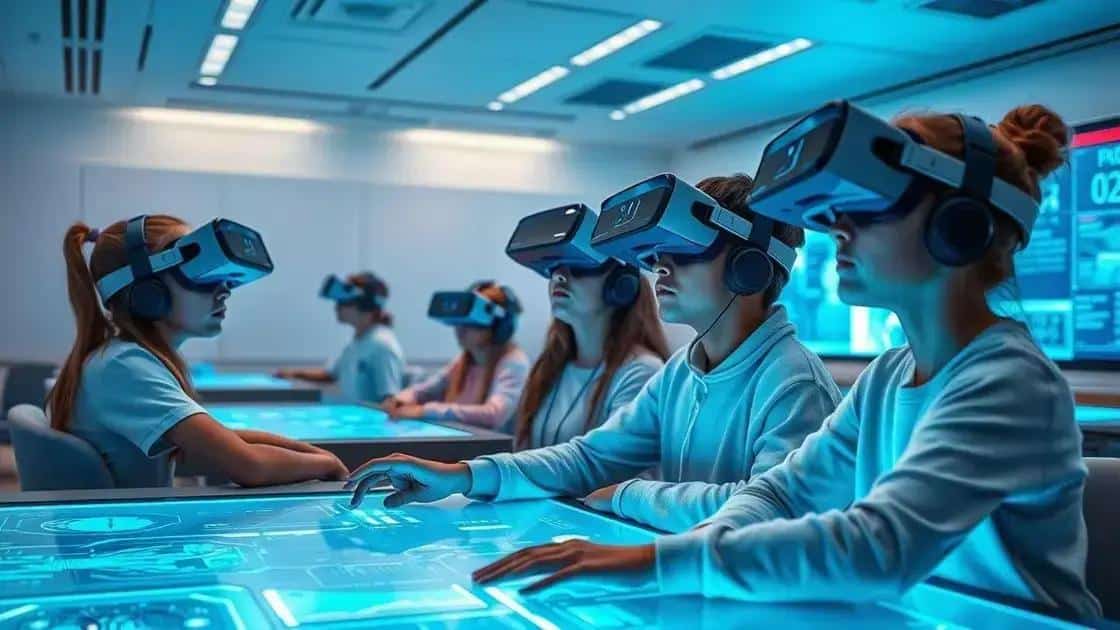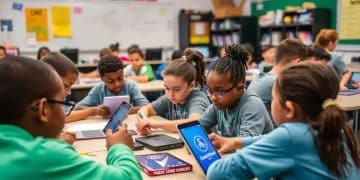School technology integration trends shaping the future

School technology integration trends focus on using AI and VR to enhance learning experiences, while also emphasizing collaboration, teacher training, and overcoming challenges like resistance and budget constraints.
School technology integration trends are changing the way students learn and teachers teach. As we navigate this digital age, understanding these trends can help schools enhance educational experiences and outcomes.
Emerging technologies in education
Emerging technologies in education are reshaping how teachers interact with students and how students engage with learning material. These innovations offer exciting opportunities to enhance educational practices.
Key Innovations in Educational Technology
Technologies such as artificial intelligence, virtual reality, and online collaboration tools are increasingly being integrated into classrooms. Each of these technologies supports different learning styles and enhances accessibility for all students.
- Artificial Intelligence: AI helps personalize learning experiences by adapting to each student’s needs.
- Virtual Reality (VR): VR immerses students in lifelike environments, making learning more engaging and effective.
- Online Collaboration Tools: Platforms like Google Classroom and Microsoft Teams facilitate easier communication and teamwork among students.
Moreover, the adoption of these technologies encourages students to develop essential skills for the future. As students use technology to collaborate on projects, they learn critical thinking and problem-solving skills that are vital for their careers. The integration of emerging technologies fosters an inclusive learning environment where every student can thrive.
The Impact of Big Data
Big data is another significant element in the education sector. By analyzing large volumes of learning data, educators can identify trends and patterns that inform their teaching strategies. This leads to optimized instruction tailored to student needs.
Furthermore, educators can track student progress more effectively, allowing for timely interventions when necessary. This data-driven approach enhances the overall learning experience by ensuring that each student receives the right support from their teachers.
As more schools implement these technologies, the educational landscape will continue to evolve. It’s essential for educators to keep abreast of these changes to prepare students for a future where technology plays a pivotal role in their lives. The integration of these advancements will not only improve educational outcomes but also inspire a new generation of learners.
Benefits of technology integration in schools

The benefits of technology integration in schools are vast and impactful. By incorporating innovative tools, educators can enhance teaching and learning experiences in countless ways.
Engagement and Motivation
One significant benefit is the increase in student engagement. When students interact with technology, they often feel more motivated to participate. This is especially true with interactive platforms and gamified learning.
- Increased Participation: Technology allows students to contribute in various ways, fostering a dynamic classroom environment.
- Personalized Learning: Technology enables tailored educational experiences that meet individual learning needs.
- Real-time Feedback: Immediate feedback helps students understand their progress and areas for improvement.
As technology becomes more integrated, students develop critical skills essential for modern workplaces. These skills include creativity, collaboration, and digital literacy. Incorporating technology helps students prepare for future challenges, as they learn to utilize various tools effectively.
Enhanced Collaboration
Another advantage is improved collaboration among students and teachers. With online platforms, communication becomes seamless and projects can be managed more efficiently. Students can work together from different locations, sharing ideas and resources without barriers.
Moreover, technology fosters a sense of community within the classroom. Students learn to share their thoughts, work on group projects, and support one another. These collaborative experiences enhance social skills and build lasting relationships.
In conclusion, the multiple benefits of technology integration create a richer learning experience. Schools embracing these advancements can better equip students for success in a digital world, nurturing skills that are vital for their future.
Challenges of implementing new technologies
Implementing new technologies in schools can bring many benefits, but it also presents several challenges. Educators and administrators must navigate these hurdles to ensure successful integration.
Resistance to Change
One of the most significant challenges is resistance to change from both educators and students. Many individuals prefer traditional teaching methods and may be hesitant to alter their established routines. Overcoming this resistance requires clear communication about the benefits of technology and ongoing support for those adapting to new methods.
- Training and Support: Providing comprehensive training for educators is essential to help them feel confident using new technologies.
- Involvement in Decision-Making: Engaging teachers and students in the technology selection process can reduce resistance and increase buy-in.
- Demonstrating Value: Showcasing successful technology integrations can encourage others to embrace change.
Another challenge is limited access to resources. Not all schools have the budget to invest in the latest tools and technologies. Budget constraints can hinder the ability to provide adequate devices and infrastructure needed for effective tech integration. Schools must prioritize spending and seek alternative funding sources, such as grants or partnerships, to ensure that all students have access to necessary resources.
Technical Issues
Technical difficulties can also pose significant challenges. Schools may encounter issues with connectivity, software compatibility, or device malfunctions. These problems can disrupt learning and frustrate both teachers and students. To mitigate these risks, schools should invest in reliable IT support and develop procedures for quickly addressing technical issues when they arise.
Furthermore, the need for ongoing maintenance and updates can overwhelm school staff. Technology is constantly evolving, and schools need to keep up with the changes. Regularly updating software and training staff can create additional workload but is necessary to maintain productivity.
In summary, while implementing new technologies in education can enhance learning experiences, it requires careful planning and support. Addressing resistance to change, managing resources, and resolving technical issues are vital for successful technology integration in schools.
Future predictions for school technology trends

Future predictions for school technology trends suggest exciting changes in the educational landscape. As technology advances, we can expect schools to adopt more innovative tools and teaching methods, which will enhance learning experiences.
Increased Use of Artificial Intelligence
One major trend is the increased use of artificial intelligence (AI) in classrooms. AI can analyze student performance and provide personalized learning experiences. This customization helps students learn at their own pace and focus on areas where they may struggle.
- Automated Grading: AI can assist teachers by automating grading, allowing them to focus on teaching.
- Real-time Feedback: AI tools can give students immediate feedback on their work, helping them improve quickly.
- Personalized Learning Plans: AI can create tailored learning plans based on each student’s strengths and weaknesses.
Additionally, schools will likely see an expansion in the use of virtual and augmented reality. These technologies can create immersive learning experiences, allowing students to explore concepts beyond traditional methods. With VR and AR, students can visit historical sites or explore molecular structures in 3D, making learning much more engaging.
Greater Emphasis on Collaborative Learning
Another trend will be the emphasis on collaborative learning environments. As technology enables students to work together from any location, schools will foster teamwork through digital platforms. This collaboration encourages communication and problem-solving skills critical for future workplaces.
Moreover, teacher training will evolve to include technology integration. Educators will participate in continuous professional development focused on effectively using technology in their classrooms. This training will ensure that teachers feel confident and prepared to implement new tools.
In summary, the future of technology in schools is promising and transformative. With AI, immersive experiences, and collaboration taking center stage, education will continue to evolve to meet the needs of today’s learners.
In conclusion, the integration of technology in schools offers immense potential to enhance learning. While challenges exist, such as resistance to change and resource constraints, the benefits far outweigh them. As schools embrace emerging technologies like AI and VR, collaboration among students and educators will become a key focus. Preparing teachers with the right training will ensure they can guide students effectively in this new digital landscape. Embracing these trends will help create dynamic learning environments, making education more engaging and accessible for all.
FAQ – Frequently Asked Questions about School Technology Integration
What are the main benefits of integrating technology in schools?
Integrating technology in schools enhances student engagement, allows for personalized learning, and promotes collaboration among students.
What challenges do schools face when implementing new technologies?
Schools may experience resistance to change, technical issues, and budget constraints, which can hinder successful technology integration.
How can teachers be supported in using new technologies?
Providing ongoing training and resources helps teachers feel confident in using new tools effectively in the classroom.
What future trends should we expect in school technology?
Expect to see increased use of artificial intelligence and virtual reality, which will help create more immersive and engaging learning experiences.





